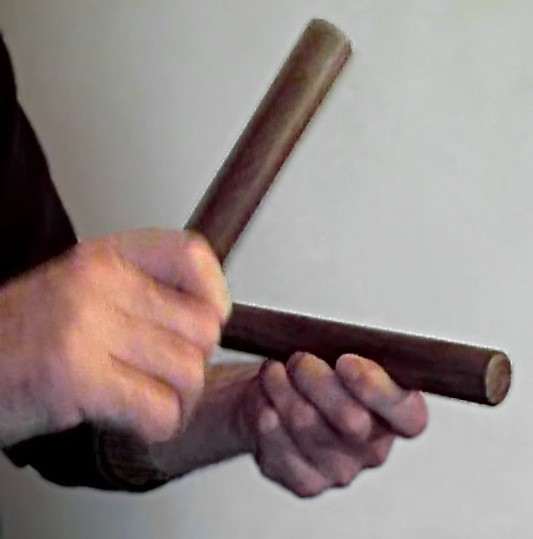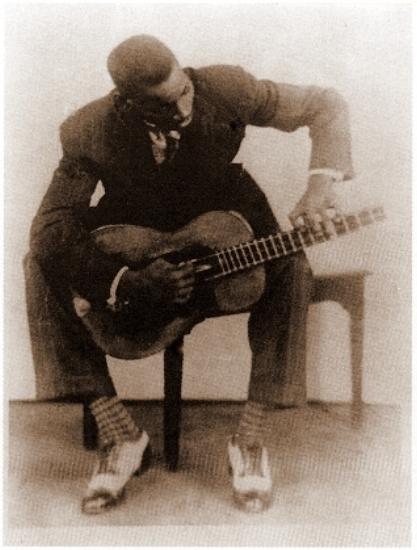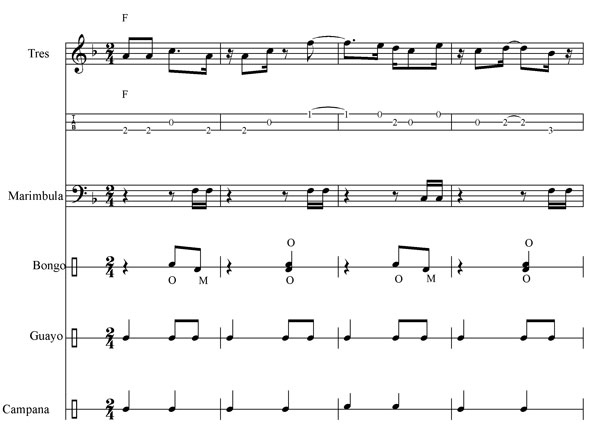|
Guajeos
A guajeo (Anglicized pronunciation: ''wa-hey-yo'') is a typical Cuban ostinato melody, most often consisting of arpeggiated chords in syncopated patterns. Some musicians only use the term ''guajeo'' for ostinato patterns played specifically by a tres, piano, an instrument of the violin family, or saxophones. Piano guajeos are one of the most recognizable elements of modern-day salsa. Piano guajeos are also known as ''montunos'' in North America, or ''tumbaos'' in the contemporary Cuban dance music timba. History The guajeo shares rhythmic, melodic and harmonic similarities with the short ostinato figures played on marimbas, lamellophones, and string instruments in sub-Saharan Africa. The guajeo is a seamless blend of African and European musical sensibilities, and was first played as accompaniment on the tres in the Afro-Cuban son and related music. The tres is a Cuban guitar-like instrument, consisting of three sets of double strings. Changüí The guajeo emerged in Cuba duri ... [...More Info...] [...Related Items...] OR: [Wikipedia] [Google] [Baidu] |
Arsenio Rodríguez
Arsenio Rodríguez (born Ignacio Arsenio Travieso Scull; 31 August 1911 – 30 December 1970)Giro, Radamés 2007. ''Diccionario enciclopédico de la música en Cuba''. La Habana, v. 4 p. 45 et seq. was a Cuban musician, composer and bandleader. He played the tres, as well as the tumbadora, and he specialized in son, rumba and other Afro-Cuban music styles. In the 1940s and 1950s Rodríguez established the ''conjunto'' format and contributed to the development of the son montuno, the basic template of modern-day salsa. He claimed to be the true creator of the mambo and was an important as well as a prolific composer who wrote nearly two hundred songs. Despite being blind since the age of seven, Rodríguez quickly managed to become one of Cuba's foremost ''treseros''. Nonetheless, his first hit, "Bruca maniguá" by Orquesta Casino de la Playa, came as a songwriter in 1937. For the following two years, Rodríguez worked as composer and guest guitarist for the Casino de la Playa, b ... [...More Info...] [...Related Items...] OR: [Wikipedia] [Google] [Baidu] |
Clave Rhythm
The clave (; ) is a rhythmic pattern used as a tool for temporal organization in Cuban music. In Spanish, ''clave'' literally means key, clef, code, or keystone. It is present in a variety of genres such as Abakuá music, rumba, conga, son, mambo, salsa, songo, timba and Afro-Cuban jazz. The five-stroke clave pattern represents the structural core of many Cuban rhythms. The clave pattern originated in sub-Saharan African music traditions, where it serves essentially the same function as it does in Cuba. In ethnomusicology, clave is also known as a ''key pattern'', ''guide pattern'', ''phrasing referent'', ''timeline'', or ''asymmetrical timeline''. The clave pattern is also found in the African diaspora music of Haitian Vodou drumming, Afro-Brazilian music, African-American music, Louisiana Voodoo drumming, and Afro-Uruguayan music (candombe). The clave pattern (or hambone, as it is known in the United States) is used in North American popular music as a rhythmic motif (music ... [...More Info...] [...Related Items...] OR: [Wikipedia] [Google] [Baidu] |
Salsa (music)
Salsa music is a style of Latin American music. Because most of the basic musical components predate the labeling of salsa, there have been many controversies regarding its origin. Most songs considered as salsa are primarily based on son montuno, with elements of mambo, Latin jazz, bomba, plena and guaracha. All of these elements are adapted to fit the basic son montuno template when performed within the context of salsa. Originally the name salsa was used to label commercially several styles of Latin dance music, but nowadays it is considered a musical style on its own and one of the staples of Latin American culture. The first self-identified salsa bands were predominantly assembled by Cuban and Puerto Rican musicians in New York City in the '70s. The music style was based on the late son montuno of Arsenio Rodríguez, Conjunto Chappottín and Roberto Faz. These musicians included Celia Cruz, Willie Colón , Rubén Blades, Johnny Pacheco, Machito and Héctor Lavoe. Du ... [...More Info...] [...Related Items...] OR: [Wikipedia] [Google] [Baidu] |
Tumbao
In music of Afro-Cuban origin, tumbao is the basic rhythm played on the bass. In North America, the basic conga drum pattern used in popular music is also called ''tumbao''. In the contemporary form of Cuban popular dance music known as timba, piano guajeos are known as ''tumbaos''. Bass pattern Clave-neutral The tresillo pattern is the rhythmic basis of the ostinato bass tumbao in Cuban son-based musics, such as son montuno, mambo, salsa, and Latin jazz. Often the last note of the measure is held over the downbeat of the next measure. In this way, only the two offbeats of tresillo are sounded. The first offbeat is known as ''bombo'', and the second offbeat (last note) is sometimes referred to as ''ponche''. The following example is written in cut-time (2/2). Clave-aligned Arsenio Rodríguez's group introduced bass tumbaos that have a specific alignment with clave. The 2-3 bass line of "Dame un cachito pa' huele" (1946) coincides with three of the clave's five strokes. Dav ... [...More Info...] [...Related Items...] OR: [Wikipedia] [Google] [Baidu] |
Ostinato
In music, an ostinato (; derived from Italian word for ''stubborn'', compare English ''obstinate'') is a motif or phrase that persistently repeats in the same musical voice, frequently in the same pitch. Well-known ostinato-based pieces include classical compositions such as Ravel's '' Boléro'' and the ''Carol of the Bells'', and popular songs such as Donna Summer and Giorgio Moroder's "I Feel Love" (1977), Henry Mancini's theme from ''Peter Gunn'' (1959), The Who's "Baba O'Riley" (1971), and The Verve's " Bitter Sweet Symphony" (1997). Both ''ostinatos'' and ''ostinati'' are accepted English plural forms, the latter reflecting the word's Italian etymology. The repeating idea may be a rhythmic pattern, part of a tune, or a complete melody in itself. Kamien, Roger (1258). ''Music: An Appreciation'', p. 611. . Strictly speaking, ostinati should have exact repetition, but in common usage, the term covers repetition with variation and development, such as the alteration of an os ... [...More Info...] [...Related Items...] OR: [Wikipedia] [Google] [Baidu] |
Tres (instrument)
The tres (Spanish for ''three'') is a three- course chordophone of Cuban origin. The most widespread variety of the instrument is the original Cuban tres with six strings. Its sound has become a defining characteristic of the Cuban son and it is commonly played in a variety of Afro-Cuban genres. In the 1930s, the instrument was adapted into the Puerto Rican tres, which has nine strings and a body similar to that of the cuatro. The tres developed in the second half of the 19th century in the eastern region of Guantánamo, where it was used to play changüí, a precursor of son cubano. Its exact origins are not known, but it is assumed to have developed from the 19th century Spanish guitar, which it resembles in shape, as well as the laúd and bandola, two instruments used in punto cubano since at least the 18th century. Tres playing revolves around the ''guajeo'', an '' ostinato'' pattern found in many Afro-Cuban music styles. Tres players are commonly known as ''treseros'' (in C ... [...More Info...] [...Related Items...] OR: [Wikipedia] [Google] [Baidu] |
Tres Cubano
The tres (Spanish for ''three'') is a three-course chordophone of Cuban origin. The most widespread variety of the instrument is the original Cuban tres with six strings. Its sound has become a defining characteristic of the Cuban son and it is commonly played in a variety of Afro-Cuban genres. In the 1930s, the instrument was adapted into the Puerto Rican tres, which has nine strings and a body similar to that of the cuatro. The tres developed in the second half of the 19th century in the eastern region of Guantánamo, where it was used to play changüí, a precursor of son cubano. Its exact origins are not known, but it is assumed to have developed from the 19th century Spanish guitar, which it resembles in shape, as well as the laúd and bandola, two instruments used in punto cubano since at least the 18th century. Tres playing revolves around the ''guajeo'', an ''ostinato'' pattern found in many Afro-Cuban music styles. Tres players are commonly known as ''treseros'' (in Cub ... [...More Info...] [...Related Items...] OR: [Wikipedia] [Google] [Baidu] |
Tres (musical Instrument)
The tres (Spanish for ''three'') is a three- course chordophone of Cuban origin. The most widespread variety of the instrument is the original Cuban tres with six strings. Its sound has become a defining characteristic of the Cuban son and it is commonly played in a variety of Afro-Cuban genres. In the 1930s, the instrument was adapted into the Puerto Rican tres, which has nine strings and a body similar to that of the cuatro. The tres developed in the second half of the 19th century in the eastern region of Guantánamo, where it was used to play changüí, a precursor of son cubano. Its exact origins are not known, but it is assumed to have developed from the 19th century Spanish guitar, which it resembles in shape, as well as the laúd and bandola, two instruments used in punto cubano since at least the 18th century. Tres playing revolves around the ''guajeo'', an '' ostinato'' pattern found in many Afro-Cuban music styles. Tres players are commonly known as ''treseros'' (in C ... [...More Info...] [...Related Items...] OR: [Wikipedia] [Google] [Baidu] |
Son (music)
Son cubano is a genre of music and dance that originated in the highlands of eastern Cuba during the late 19th century. It is a syncretic genre that blends elements of Spanish and African origin. Among its fundamental Hispanic components are the vocal style, lyrical metre and the primacy of the tres, derived from the Spanish guitar. On the other hand, its characteristic clave rhythm, call and response structure and percussion section ( bongo, maracas, etc.) are all rooted in traditions of Bantu origin. Around 1909 the son reached Havana, where the first recordings were made in 1917. This marked the start of its expansion throughout the island, becoming Cuba's most popular and influential genre. While early groups had between three and five members, during the 1920s the ''sexteto'' (sextet) became the genre's primary format. By the 1930s, many bands had incorporated a trumpet, becoming ''septetos'', and in the 1940s a larger type of ensemble featuring congas and piano became th ... [...More Info...] [...Related Items...] OR: [Wikipedia] [Google] [Baidu] |
Changüí
''Changüí'' is a style of Cuban music which originated in the early 19th century in the eastern region of Guantánamo Province, specifically Baracoa. It arose in the sugar cane refineries and in the rural communities populated by slaves. ''Changüí'' combines the structure and elements of Spain's ''canción'' and the Spanish guitar with African rhythms and percussion instruments of Bantu origin. Changüí is considered a predecessor of ''son montuno'' (the ancestor of modern salsa), which has enjoyed tremendous popularity in Cuba throughout the 20th century. Changüí is related to the other regional genres of ''nengón'' and ''kiribá'' and is descended from ''nengón.'' Technically, the changüi ensemble consists of: marímbula, bongos, tres, güiro (or guayo) and one or more singers. Changüi does not use the Cuban ''key pattern'' (or guide pattern) known as ''clave''.Lapidus, Ben (2008) p. 140. The tres typically plays offbeat guajeos (ostinatos), while the guayo plays on ... [...More Info...] [...Related Items...] OR: [Wikipedia] [Google] [Baidu] |
Son Cubano
Son cubano is a genre of music and dance that originated in the highlands of eastern Cuba during the late 19th century. It is a syncretic genre that blends elements of Spanish and African origin. Among its fundamental Hispanic components are the vocal style, lyrical metre and the primacy of the tres, derived from the Spanish guitar. On the other hand, its characteristic clave rhythm, call and response structure and percussion section ( bongo, maracas, etc.) are all rooted in traditions of Bantu origin. Around 1909 the son reached Havana, where the first recordings were made in 1917. This marked the start of its expansion throughout the island, becoming Cuba's most popular and influential genre. While early groups had between three and five members, during the 1920s the ''sexteto'' (sextet) became the genre's primary format. By the 1930s, many bands had incorporated a trumpet, becoming ''septetos'', and in the 1940s a larger type of ensemble featuring congas and piano became th ... [...More Info...] [...Related Items...] OR: [Wikipedia] [Google] [Baidu] |
Cuba
Cuba ( , ), officially the Republic of Cuba ( es, República de Cuba, links=no ), is an island country comprising the island of Cuba, as well as Isla de la Juventud and several minor archipelagos. Cuba is located where the northern Caribbean Sea, Gulf of Mexico, and Atlantic Ocean meet. Cuba is located east of the Yucatán Peninsula (Mexico), south of both the American state of Florida and the Bahamas, west of Hispaniola ( Haiti/Dominican Republic), and north of both Jamaica and the Cayman Islands. Havana is the largest city and capital; other major cities include Santiago de Cuba and Camagüey. The official area of the Republic of Cuba is (without the territorial waters) but a total of 350,730 km² (135,418 sq mi) including the exclusive economic zone. Cuba is the second-most populous country in the Caribbean after Haiti, with over 11 million inhabitants. The territory that is now Cuba was inhabited by the Ciboney people from the 4th millennium BC with the Gua ... [...More Info...] [...Related Items...] OR: [Wikipedia] [Google] [Baidu] |







